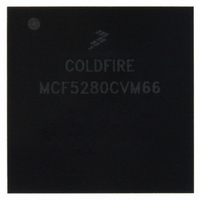MCF5280CVM66 Freescale Semiconductor, MCF5280CVM66 Datasheet - Page 192

MCF5280CVM66
Manufacturer Part Number
MCF5280CVM66
Description
IC MPU 32BIT COLDF 256-MAPBGA
Manufacturer
Freescale Semiconductor
Series
MCF528xr
Datasheet
1.MCF5216CVM66J.pdf
(766 pages)
Specifications of MCF5280CVM66
Core Processor
Coldfire V2
Core Size
32-Bit
Speed
66MHz
Connectivity
CAN, EBI/EMI, Ethernet, I²C, SPI, UART/USART
Peripherals
DMA, LVD, POR, PWM, WDT
Number Of I /o
142
Program Memory Type
ROMless
Ram Size
64K x 8
Voltage - Supply (vcc/vdd)
2.7 V ~ 3.6 V
Data Converters
A/D 8x10b
Oscillator Type
External
Operating Temperature
-40°C ~ 85°C
Package / Case
256-MAPBGA
Controller Family/series
ColdFire
No. Of I/o's
150
Program Memory Size
2KB
Ram Memory Size
64KB
Cpu Speed
66.67MHz
Embedded Interface Type
CAN, I2C, SPI, UART
No. Of Pwm Channels
8
Rohs Compliant
Yes
Lead Free Status / RoHS Status
Lead free / RoHS Compliant
Eeprom Size
-
Program Memory Size
-
Available stocks
Company
Part Number
Manufacturer
Quantity
Price
Company:
Part Number:
MCF5280CVM66
Manufacturer:
FREESCAL
Quantity:
151
Company:
Part Number:
MCF5280CVM66
Manufacturer:
Freescale Semiconductor
Quantity:
10 000
Company:
Part Number:
MCF5280CVM66J
Manufacturer:
Freescale Semiconductor
Quantity:
10 000
Company:
Part Number:
MCF5280CVM66L
Manufacturer:
FREESCAL
Quantity:
151
- Current page: 192 of 766
- Download datasheet (9Mb)
Interrupt Controller Modules
Section 2.3.3.1, “Exception Stack Frame
After the exception stack frame is stored in memory, the processor accesses the 32-bit pointer from the
exception vector table using the vector number as the offset, and then jumps to that address to begin
execution of the service routine. After the status register is stored in the exception stack frame, the SR[I]
mask field is set to the level of the interrupt being acknowledged, effectively masking that level and all
lower values while in the service routine. For many peripheral devices, the processing of the IACK cycle
directly negates the interrupt request, while other devices require that request to be explicitly negated
during the processing of the service routine.
For this device, the processing of the interrupt acknowledge cycle is fundamentally different than previous
68K/ColdFire cores. In the new approach, all IACK cycles are directly handled by the interrupt controller,
so the requesting peripheral device is not accessed during the IACK. As a result, the interrupt request must
be explicitly cleared in the peripheral during the interrupt service routine. For more information, see
Section 10.1.1.3, “Interrupt Vector
Unlike the M68000 family, all ColdFire processors guarantee that the first instruction of the service routine
is executed before sampling for interrupts is resumed. By making this initial instruction a load of the SR,
interrupts can be safely disabled, if required.
During the execution of the service routine, the appropriate actions must be performed on the peripheral
to negate the interrupt request.
For more information on exception processing, see the ColdFire Programmer’s Reference Manual at
http://www.freescale.com/coldfire.
10.1.1
To support the interrupt architecture of the 68K/ColdFire programming model, the combined 63 interrupt
sources are organized as 7 levels, with each level supporting up to 9 prioritized requests. Consider the
interrupt priority structure shown in
to lowest.
10-2
Interrupt Controller Theory of Operation
MCF5282 and MCF5216 ColdFire Microcontroller User’s Manual, Rev. 3
Interrupt
ICR[IL]
Level
Table 10-1. Interrupt Priority Scheme
7
Determination.”
Table
Definition” for more information on the stack frame format).
10-1, which orders the interrupt levels/priorities from highest
— (Mid-point)
Priority
ICR[IP]
7
6
5
4
3
2
1
0
Supported Interrupt
#7 (IRQ7)
Sources
#8–63
#8–63
Freescale Semiconductor
Related parts for MCF5280CVM66
Image
Part Number
Description
Manufacturer
Datasheet
Request
R
Part Number:
Description:
Manufacturer:
Freescale Semiconductor, Inc
Datasheet:
Part Number:
Description:
Manufacturer:
Freescale Semiconductor, Inc
Datasheet:
Part Number:
Description:
Manufacturer:
Freescale Semiconductor, Inc
Datasheet:
Part Number:
Description:
Manufacturer:
Freescale Semiconductor, Inc
Datasheet:
Part Number:
Description:
Manufacturer:
Freescale Semiconductor, Inc
Datasheet:
Part Number:
Description:
Manufacturer:
Freescale Semiconductor, Inc
Datasheet:
Part Number:
Description:
Manufacturer:
Freescale Semiconductor, Inc
Datasheet:
Part Number:
Description:
Manufacturer:
Freescale Semiconductor, Inc
Datasheet:
Part Number:
Description:
Manufacturer:
Freescale Semiconductor, Inc
Datasheet:
Part Number:
Description:
Manufacturer:
Freescale Semiconductor, Inc
Datasheet:
Part Number:
Description:
Manufacturer:
Freescale Semiconductor, Inc
Datasheet:
Part Number:
Description:
Manufacturer:
Freescale Semiconductor, Inc
Datasheet:
Part Number:
Description:
Manufacturer:
Freescale Semiconductor, Inc
Datasheet:
Part Number:
Description:
Manufacturer:
Freescale Semiconductor, Inc
Datasheet:
Part Number:
Description:
Manufacturer:
Freescale Semiconductor, Inc
Datasheet:











